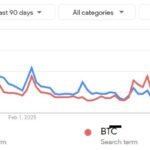The first quarter of 2025 has shed light on the evolution of decentralized finance (DeFi), revealing both challenges and innovative advancements within the sector. A notable trend has emerged: yields on major lending platforms have experienced a significant compression, marking a departure from the previously exuberant returns seen in late 2024. The benchmark yield, as per vaults.fyi, has dipped below 3.1%, falling behind the U.S. 1-month T-bill yield, which hovers around 4.3%—a first since late 2023. Such figures indicate a shift in borrower demand on these platforms, suggesting a cooling market after a period of rampant growth.
“This decline in yields highlights the maturing nature of DeFi as it navigates its way through a more subdued phase of borrower activity,”
With yields declining, it may seem counterintuitive that total value locked (TVL) in major stablecoin vaults has surged, nearly quadrupling from billion to approximately billion over the past year. This rise demonstrates an intriguing trend: while returns have diminished, there’s a growing trust in DeFi protocols as credible financial infrastructures instead of merely speculative tools. Even amidst rate cuts from platforms like Spark, which have reduced rates from 12.5% to currently around 4.5%, user engagement remains robust.
Adding to this mix are the “curators,” who represent a transformative shift in DeFi lending. Platforms like Morpho and Euler have pioneered the introduction of these asset managers, who not only evaluate but actively manage lending vaults. This role encompasses risk assessment and capital allocation strategies, enabling more nuanced approaches to maximizing yields. Unlike traditional service providers, these curators bring a hands-on strategy that can significantly impact performance and revenue generation.
“The emergence of curators highlights an evolving landscape within DeFi, demonstrating that sophisticated management strategies can still yield competitive returns, even in a compressed market,”
In this layered market, users now navigate a more complex environment where yields depend on the interplay between protocol efficiency and strategy sophistication. The persistence of Ethereum mainnet as a host for lucrative yield opportunities—despite the growing number of alternative platforms—underscores its continued dominance in driving DeFi innovation.
The rise of fintech companies like Coinbase, integrating DeFi capabilities directly into user-friendly interfaces, reflects the “DeFi Mullet” concept: traditional financial technologies occupying the front, with DeFi’s robust infrastructure operating seamlessly behind the scenes. This development could signify a pivotal moment in making DeFi more accessible to the average user without needing in-depth knowledge of the underlying technology.
As we look ahead to the remainder of 2025, several catalysts could reshape the lending landscape, including democratized curation, integration of real-world assets, and increased institutional adoption. These factors suggest that DeFi is more than just a trend; it is on a trajectory to become an integral component of the broader financial ecosystem.

DeFi’s Evolution in the First Quarter of 2025
The first quarter of 2025 has showcased notable developments in the DeFi landscape, highlighting challenges and innovations that could impact your investment strategies and understanding of decentralized finance.
- The Great Yield Compression:
- DeFi yields across major platforms have declined sharply, dropping below 3.1%.
- This is a significant fall from nearly 14% at the end of 2024, indicating a cooling market.
- The decline may influence investor behaviors as they seek alternative yield opportunities.
- Growth amidst Lower Yields:
- Major vaults have experienced substantial growth, with deposits swelling from billion to billion over the past year.
- This demonstrates increasing institutional confidence in DeFi as a legitimate financial infrastructure, which could enhance participation rates.
- The Rise of Curators:
- Curators are emerging as a new kind of asset manager in DeFi, optimizing lending vaults for better yields and risk management.
- They bridge the gap between passive lending and active capital management, potentially leading to improved returns for investors.
- As these roles expand, individual investors may benefit from more tailored investment strategies.
- Protocol Stratification:
- The market is becoming layered with distinct categories, such as blue-chip infrastructures and platform optimizers.
- This separation allows users to navigate options more effectively, balancing safety with potential high yields.
- Investors may need to adjust their strategies based on the increasing complexity of this market structure.
- Chain by Chain: Yield Opportunities:
- Ethereum continues to lead in yield generation, though newer chains with strong incentives are emerging.
- This persistence highlights the importance of staying informed about where to allocate assets for optimal returns.
- FinTech Integration with DeFi:
- Coinbase’s integration of Bitcoin-collateralized loans exemplifies a hybrid finance model, making DeFi more accessible.
- Such developments suggest a future where users engage with DeFi protocols effortlessly through familiar interfaces.
- Future Catalysts for Change:
- Democratized curation and AI integration could empower more users to optimize their investment strategies.
- Real-world asset integration may introduce alternative yield sources, diversifying investment opportunities.
- Institutional adoption could significantly alter lending dynamics, impacting yield availability and market access.
“This is a moment where we’re planting a flag that Coinbase is coming on-chain, and we’re bringing millions of users with their billions of dollars.” – Max Branzburg, Coinbase’s Head of Consumer Products
Analyzing the Current Landscape of DeFi Lending in Early 2025
The first quarter of 2025 has been transformative for the decentralized finance (DeFi) sector, offering insights into both challenges and opportunities within the space. As yield rates decline across major lending platforms, a noticeable trend has emerged with the growth of innovative strategies and new players entering the market. This changing landscape is reflective of a sector maturing and adapting amid evolving market conditions, especially when compared to similar trends in the broader financial ecosystem.
Competitive Advantages: One of the most significant advantages observed in recent months is the remarkable scalability of DeFi vaults, which have exhibited substantial growth despite the ongoing yield compression. Major platforms like Aave, Compound, and the emerging curators such as Morpho and Euler have demonstrated that there is a robust appetite for decentralized lending products. With TVL (Total Value Locked) on established vaults surging from around billion to billion, it’s evident that institutions and retail investors alike have developed a greater reliance on DeFi as a dependable financial infrastructure. The rise of curators as asset managers, who optimize capital allocation and risk management, adds a layer of sophistication that could attract further institutional interest, thus ensuring that strategic players in the DeFi space remain competitive.
Competitive Disadvantages: However, the environment is not without its drawbacks. As yields fall below traditional benchmarks, such as the U.S. 1-month T-bill, some investors may feel disillusioned, leading to potential liquidity issues for platforms that depend on yield attractiveness. The sheer complexity of navigating multiple strategies and protocols also presents a barrier, particularly for less experienced users. The stratification of the market into blue-chip services and more innovative, complex platforms may confuse retail investors, ultimately affecting liquidity and participation rates in the DeFi ecosystem.
Beneficial Implications: Institutional investors stand to gain significantly from this evolving landscape. As they become more comfortable with DeFi, they can leverage curated strategies that promise higher yields, target specific risk appetites, and offer a diverse range of services beyond traditional finance. Additionally, platforms that strike the right balance between risk and reward management will appeal to both conservative and aggressive investors, ensuring sustained capital inflow.
Potential Problems: Conversely, lower yield environments pose a challenge for traditional investors who are accustomed to higher returns. These investors may find themselves struggling to adapt to a market that is consolidating on quality over quantity. Moreover, platforms that cannot adequately innovate or cater to varying investor needs may face increasing competition that threatens their long-term viability.
As we navigate through 2025, the financial landscape of DeFi will likely be characterized by robust institutional participation and an intricate mix of offerings. The integration of DeFi capabilities into user-friendly platforms like Coinbase illustrates a pivotal moment of growth, indicating that while traditional financial interfaces remain prominent, the underlying DeFi infrastructures are critical for the next phase of financial evolution.

















